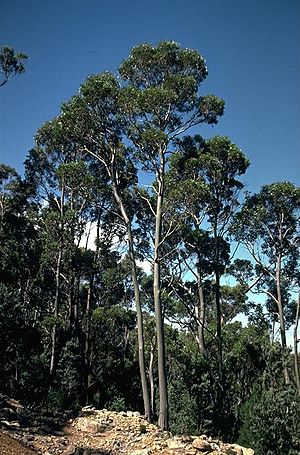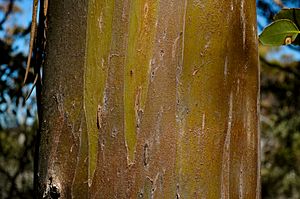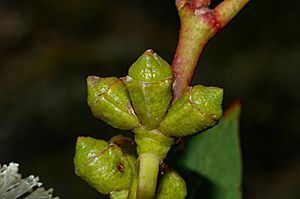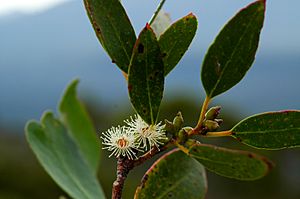Tasmanian alpine yellow gum facts for kids
Quick facts for kids Tasmanian alpine yellow gum |
|
|---|---|
 |
|
| Eucalyptus subcrenulata in Mount Field National Park | |
| Scientific classification | |
| Genus: |
Eucalyptus
|
| Species: |
subcrenulata
|
The Tasmanian alpine yellow gum (Eucalyptus subcrenulata) is a special type of tree. It only grows in the high mountains of Tasmania, an island in Australia. This tree is usually small to medium-sized.
It has smooth bark and shiny green leaves. Its leaves can be shaped like a spear or an egg. It grows white flowers in groups of three. The fruit looks like a half-sphere or a bell. It looks a bit like other gum trees, such as the Tasmanian yellow gum, Varnished gum, and Urn tree.
Contents
What Does This Tree Look Like?
The Tasmanian alpine yellow gum usually grows to be about 18 to 20 meters (60-65 feet) tall. Sometimes, it can grow much taller, up to 60 meters (nearly 200 feet)! It has a special woody lump at its base called a lignotuber. This helps the tree regrow if it gets damaged.
Bark and Young Leaves
The bark of this tree is smooth. It can be pale grey, brown, or yellowish. You might see black marks on the bark that go across the tree. Young plants and new shoots have stems that are square-shaped. They sometimes have a small "wing" on each corner. Their leaves grow directly on the stem, in pairs opposite each other. These young leaves are egg-shaped or round and shiny green. They are about 30-85 mm (1-3 inches) long and 30-50 mm (1-2 inches) wide. They often have tiny teeth along their edges.
Adult Leaves
The adult leaves are arranged differently, not in opposite pairs. They are shaped like a spear or an egg. Both sides of the leaf are the same shiny green color. They are about 52-135 mm (2-5 inches) long and 20-45 mm (0.8-1.8 inches) wide. The leaf narrows down to a stalk called a petiole, which is about 15-37 mm (0.6-1.5 inches) long. Sometimes, these adult leaves also have small teeth on their edges. If you crush the leaves, they have a strong spicy smell.
Flowers and Fruit
The flower buds grow in groups of three. They are found where the leaves meet the stem. Each group of buds sits on a short stalk, about 2-6 mm (0.08-0.24 inches) long. The buds themselves are oval-shaped, about 6-8 mm (0.24-0.31 inches) long and 4-6 mm (0.16-0.24 inches) wide. They have a rounded or beaked cap on top.
The Tasmanian alpine yellow gum flowers from November to May. The most flowers appear between January and March. The flowers are white. After flowering, the tree produces woody fruit. These fruits are shaped like a half-sphere or a bell. They are about 5-7 mm (0.2-0.28 inches) long and 5-9 mm (0.2-0.35 inches) wide. The parts that open to release seeds are usually level with the rim of the fruit.
How This Tree Got Its Name
The Tasmanian alpine yellow gum was first officially described in 1929. Two scientists, Joseph Maiden and William Blakely, gave it the scientific name Eucalyptus subcrenulata. They wrote about it in a book called A Critical Revision of the Genus Eucalyptus. Joseph Maiden had collected samples of the tree near Mount Field National Park in 1906.
The name subcrenulata comes from two Latin words. "Sub-" means "somewhat" or "not completely." "Crenulatus" means "having small, rounded teeth." This name refers to the small teeth often found on the edges of the tree's leaves.
Where Does This Tree Grow?
Eucalyptus subcrenulata grows in the high mountains of Tasmania. You can find it on exposed ridges, flat areas (plateaus), and slopes. It lives in subalpine woodlands. This includes places like the central and western highlands, such as Mount Field National Park and the Great Western Tiers. It often grows alongside another gum tree called E. coccifera in these exposed mountain areas.
Growing This Tree in Gardens
The Tasmanian alpine yellow gum grows best in soil that drains water well. It also needs a sunny spot. It can handle frost, but you need to keep it watered, especially when it's young. People in New Zealand and Britain have found that this tree is very good at surviving cold weather. Some experts even think it could be a good tree to plant in milder parts of the United Kingdom.




